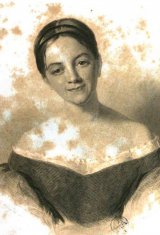The Volcano of Ki-rau-e-a
Letitia Elizabeth Landon 1802 (Chelsea) – 1838 (Cape Coast)
An ebbing tide of fire, the evil powers
In fear and anger here are paramount,
Rending the bosom of the fertile earth,
And spreading desolation. Black as night,
And terrible, as if the grave had sent
Its own dark atmosphere to upper air,
The heavy vapours rise ; from out the smoke
Break the red volumes of the central flame,
And lava floods and burning showers descend,
Parching the soil to barrenness.
And yet there is the principle of life
Within that fiery waste : when years have past,
And Time, the beautifier, has been there,
Then will the fierce volcano have consumed
Its depths of flame, and there the coral reef
Will spread ; at first a bleak and dangerous waste;
Until the wind bear on its wandering wings
The fertilizing seeds; the salt sea tide
Leave shells and weeds behind, to vegetate.
The birds will come o'er ocean, and delight
To find a tranquil home remote from men.
Flowers will spring up, and trees ; and last some ship
Will penetrate the waste of waters round,
And marvel at the lovely solitude.
" Standing at an elevation of one thousand five hundred feet, we looked into a black and horrid gulf, not less than eight miles in circumference, so directly beneath us, that, in appearance, we might, by a single leap, have plunged into its lowest depth. The hideous immensity itself, independent of the many frightful images which it embraced, almost caused an involuntary closing of the eyes against it. But when to the sight is added the appalling effect of the various unnatural and fearful noises, the muttering and sighing, the groaning and blowing, the every agonized struggling, of the mighty action within, as a whole, it is too horrible. And for the first moment I felt like one of my friends, who, on reaching the brink, recoiled, and covered his face, exclaiming, "Call it weakness, or what you please, but I cannot look again."—p. 375.
According to the theory generally received at present among scientific men, the numerous coral islands of the Pacific are supposed to be formations upon extinct volcanoes.
Font size:
Submitted by Madeleine Quinn on June 23, 2016
Modified on March 05, 2023
- 1:45 min read
- 76 Views
Quick analysis:
| Scheme | AXXBXCXXXAXXCXXXXXXBXXXX X X |
|---|---|
| Characters | 2,021 |
| Words | 352 |
| Stanzas | 3 |
| Stanza Lengths | 24, 1, 1 |
Translation
Find a translation for this poem in other languages:
Select another language:
- - Select -
- 简体中文 (Chinese - Simplified)
- 繁體中文 (Chinese - Traditional)
- Español (Spanish)
- Esperanto (Esperanto)
- 日本語 (Japanese)
- Português (Portuguese)
- Deutsch (German)
- العربية (Arabic)
- Français (French)
- Русский (Russian)
- ಕನ್ನಡ (Kannada)
- 한국어 (Korean)
- עברית (Hebrew)
- Gaeilge (Irish)
- Українська (Ukrainian)
- اردو (Urdu)
- Magyar (Hungarian)
- मानक हिन्दी (Hindi)
- Indonesia (Indonesian)
- Italiano (Italian)
- தமிழ் (Tamil)
- Türkçe (Turkish)
- తెలుగు (Telugu)
- ภาษาไทย (Thai)
- Tiếng Việt (Vietnamese)
- Čeština (Czech)
- Polski (Polish)
- Bahasa Indonesia (Indonesian)
- Românește (Romanian)
- Nederlands (Dutch)
- Ελληνικά (Greek)
- Latinum (Latin)
- Svenska (Swedish)
- Dansk (Danish)
- Suomi (Finnish)
- فارسی (Persian)
- ייִדיש (Yiddish)
- հայերեն (Armenian)
- Norsk (Norwegian)
- English (English)
Citation
Use the citation below to add this poem to your bibliography:
Style:MLAChicagoAPA
"The Volcano of Ki-rau-e-a" Poetry.com. STANDS4 LLC, 2024. Web. 16 Apr. 2024. <https://www.poetry.com/poem/44898/the-volcano-of-ki-rau-e-a>.



Discuss the poem The Volcano of Ki-rau-e-a with the community...
Report Comment
We're doing our best to make sure our content is useful, accurate and safe.
If by any chance you spot an inappropriate comment while navigating through our website please use this form to let us know, and we'll take care of it shortly.
Attachment
You need to be logged in to favorite.
Log In